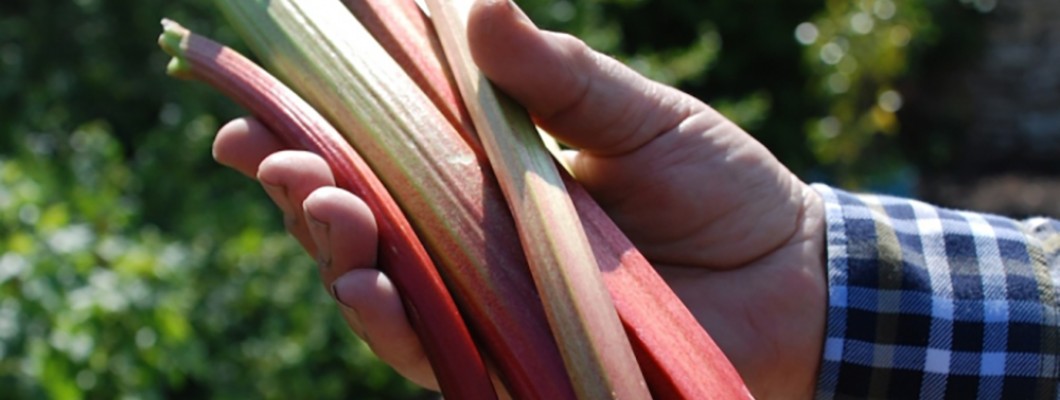
The following recipe has been kindly contributed by Vivien Lloyd, who is a renowned preserver, baker, author and tutor. She has appeared on various TV and radio shows, and is regularly featured in the press. She is an author of a number of books, including the excellent “First Preserves – marmalades, jams, chutneys”; which is an authoritative guide featuring reliable recipes and explanations that are not found elsewhere. Ideal for both novices and experienced preservers and available now from The Bottle Co, her website and Amazon. To find out more about Vivien Lloyd check out her website.
In this recipe Vivien shares here secrets for making Rhubarb Jam
Widely considered a fruit, rhubarb is a vegetable which is cooked and eaten like fruit. Rhubarb is classified as a soft fruit in preserves competitions.
Rhubarb originated in Asia and was introduced into Europe in the fourteenth century. Monks grew rhubarb for ornamental and medicinal purposes, before its culinary uses were discovered. Only the stalks of rhubarb are edible. The leaves contain oxalic acid which is poisonous to humans and animals.
Rhubarb is easy to grow. The stalks vary in colour from green to red and early or forced rhubarb has pink, tender stalks. It can be grown from seed but usually gardeners buy plants, at least a year old. Established plants, known as crowns, can be divided during the winter. Crowns should be divided every five to six years, and any flower shoots removed as they appear during the summer. Rhubarb needs plenty of water and should not shade other plants. Surround the crowns with well rotted manure during the winter months. My rhubarb thrives in a small patch in front of a greenhouse. From just three crowns, I always have more rhubarb than I can preserve.
Rhubarb has a long season, forced rhubarb from Early January to mid- March, and the main crop from mid-March through to September. Popular varieties include Timperley Early, Champagne, Victoria and Raspberry Red.
As it is the first fruit available to the preserver, it is tempting to make jam from the forced varieties. However, I prefer to use forced rhubarb in desserts as it can be watery if made into jam. Rhubarb is low in pectin and acid. It is often paired with medium pectin fruits, raspberries or loganberries for jam. As a Rhubarb jam, it is often flavoured with ginger or orange. Here is a recipe for a jam with ginger.
Competitions
As a judge I look for a sealed jar which “pops” when opened and filled to within 3mm from the top. The jam should be set, have a bright, even colour, without scum or air bubbles. The consistency should be spreadable, not stiff or runny. I award most of my marks for the flavour of the jam, full, fresh, balanced and true. If you are tempted to use Jam Sugar(sugar with added pectin) be aware the colour of the jam will be unnaturally bright and the consistency firm, as it is easy to overset jam using this sugar.
Rhubarb and Ginger Jam
1.4kg Rhubarb, prepared stalks
125g stem ginger, finely sliced
Juice of 2 large lemons
1.4kg granulated, cane sugar
1. Wipe the rhubarb and cut into 5cm pieces. Add the rhubarb, stem ginger and lemon juice to a large, lidded preserving pan. Finely chop the lemons and tie them up in a muslin bag. Add this to the pan. Warm the sugar in an ovenproof bowl in a low oven 140C /275F/Gas1.
2. Place the lid on the pan and simmer the ingredients very slowly over a low heat until the fruit us well broken down. Lift the muslin bag and using a spoon press any liquid against the side of the pan back into the pan. Remove the sugar from the oven, and place the jars in the oven for 10 minutes to warm through.
3. Stir in the sugar until thoroughly dissolved. Bring the jam to a rolling boil and boil hard until setting point is reached. After 5 minutes, test for a set using the flake, cold plate or thermometer test.
4. As soon as setting point is reached, remove the pan from the heat and leave it to stand for a few minutes. Push any scum from the surface of the pan to the side and remove it with a metal spoon.
5. Gently stir the jam and pour it into the jars, up to the brim. Seal the jars immediately, with new, twist top lids. Leave the jars upright and undisturbed to set.
-1000x562.jpg)

